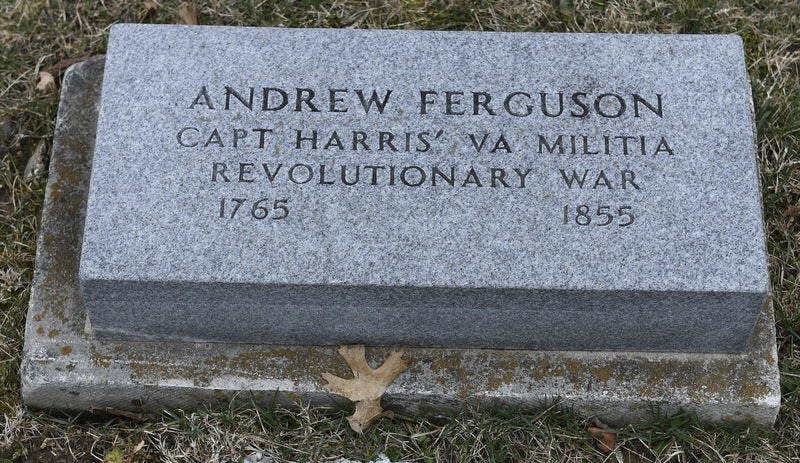Revolutionary War vet helped settle Monroe County. Why he remained in obscurity for a century
Editor's note: In honor of Black History Month, The Herald-Times is publishing Black stories, both current and historical, throughout the month of February. Look for them on weekdays. Send your feedback and suggestions about this series to rksmith@heraldt.com.
For over a hundred years, Andrew Ferguson's remains laid in an unmarked grave somewhere in the Rose Hill Cemetery, his army service and contributions to Monroe County largely forgotten by his chosen community. The veteran was among thousands of Black soldiers who fought against British forces during the Revolutionary War, contributing to a number of key battles that ultimately secured the United States' sovereignty.
However, in the century since, Ferguson's history has been brought to the forefront and re-examined. Here's everything historians have been able to gather about one of Monroe County's earliest Black settlers.

How a Black Revolutionary War veteran ended up in Indiana
Andrew Ferguson was born around 1760 in Virginia, about 16 years before the U.S. would gain independence. Ferguson was 15 when he enlisted in the Continental Army, his decision believed to have been influenced by a traumatic altercation with British troops, who harassed him and his father for information on the Patriots. When Ferguson and his father refused to help, they were whipped with a cat-o-nine tail and held prisoner.
After escaping captivity, the two men met up with some Patriot troops stationed in Virginia and ultimately both enlisted to serve the U.S. cause. Though rarely acknowledged, it wasn't unheard of for Black soldiers to fight in the Revolutionary War. Modern historians project the number of Black soldiers to be somewhere around 5,000.
Ferguson was still a teenager when he participated in a number of pivotal battles, including Kings Mountain, Cowpens and Guilford Courthouse. He re-enlisted several times with his war pension application stating he served a total of five years and six months.
Though he kept his life, Ferguson is not believed to have left the war unscathed, as noted in a past H-T article. He suffered injuries in the head and leg, the former having been treated by the insertion of a plate made of hammered silver coins and the latter continuing to cause complications later in his life. After the war was over, Ferguson spent time in North Carolina and Virginia before ultimately moving to southern Indiana. He lived in Vincennes around the early 1820s, where his war pension was initially denied by officials because he was Black.
He had settled in Bloomington by 1830. At that point, Monroe County, first formed in 1818, was in its infancy. During Ferguson's time in the area, the county's Black population wildly fluctuated. As noted in the 1830 census, 70 free people of color were living in Monroe. That count sharply declined to 13 residents by 1840. Ferguson was among the few who stayed long-term, living in Bloomington for more than two decades. Ferguson later found love here, marrying Jane “Jenny” Murphy in the mid-1840s. The couple lived together in a cabin on South Lincoln Street.
In addition to receiving his army pension of $20 per year, he worked odd jobs around the city for income. Due to his military service, Ferguson was eligible for a land warrant of 160 acres, but he and his wife died before final approval arrived. He died in 1855, believed to have been around the age of 95.
How Ferguson is remembered, immortalized today
The Indiana Historical Society recognizes Ferguson as one of Monroe County's most prominent African American settlers in its early formation. In 1984, he finally received a headstone, dedicated by the Daughters of the American Revolution. In 2016, a bronze marker was placed at Kings Mountain National Military Park to memorialize Black soldiers who served during the Battle of Kings Mountain; Ferguson’s name is engraved on it.
With surviving historical records about Ferguson being scant, it was a major local effort to research this veteran's life, but the work proved to be invaluable. Ferguson's legacy as a soldier and early resident of Monroe County will continue to live on in stone and bronze.
"He possessed an inspiring grit and determination to succeed in a world that was less than kind to him simply because of the color of his skin,” Sheryl Vanderstel, local historian, told the Herald-Times in 2018. “I admire him tremendously. His long life is a testament to perseverance, honesty and honor. We should all aspire to a life like that.”
This article originally appeared on The Herald-Times: Black Revolutionary War veteran helped settle southern Indiana

